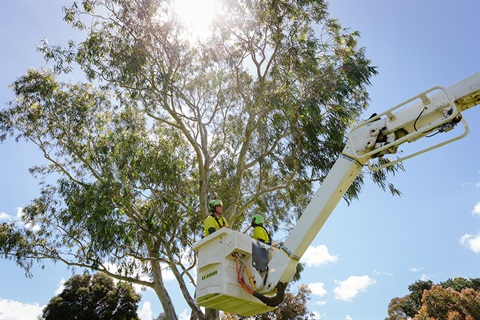Street and Reserve Trees

Trees are not only beautiful, but also essential for our well-being. They improve the quality of our surroundings by capturing carbon, filtering pollutants, producing oxygen, reducing heat on hot days through shading, cooling the air, providing shelter and food for wildlife. They also help to manage storm water runoff, preventing erosion and flooding. Trees are a valuable asset for our neighbourhoods and our planet.
View our policies, related strategies, notes and procedures:
For information on the construction of naturestrips and approved alternative treatments view Residential Naturestrip Policy(, 0B)
For our plan to support working toward compliance with the Electricity Safety (Electric Line Clearance) Regulations 2020 view Electric Line Clearance Management Plan(PDF, 6MB)
Tree planting
We plant thousands of trees each year across Hume City and maintain trees across reserves, urban areas and other properties managed by Council.
In 2025, we plan to plant 4,300 trees as part of our planting schedule which includes requested and trial trees.
We estimate it will take approximately five years to move through all areas of Hume before we rotate back to the start again.
View the map below to see tree planting in your area.
Street Tree Planting 2025
This element requires javascript to be enabled.Please wait while we load your map...
Tree management
We prune and manage trees on Council managed land including proactive and reactive tree inspections, manage pest and diseases, provide information on debris from Council trees, advice for tree roots and stormwater pipes and information about tree removal.
Proactive tree inspections
Council has a proactive inspection and pruning program, where each street tree is inspected by a qualified arborist.
These inspections assess the health and structure of the tree and identify if any pruning or removal works are required. If street trees are underneath powerlines, they are assessed by a qualified arborist every 12 months for compliance with the Electricity Safety (Electric Line Clearance) Regulations 2015.
Pest and disease
Generally, trees recover from infestation without human intervention. Some of Council’s trees require proactive treatment for insects, for example, our elm trees require treatment for elm leaf beetle.
Sometimes, trees need to be protected from our native fauna, for example the leaves of mature red gum trees can be eaten by possums, and if the possums are not prevented from accessing the canopy, the tree may die.
Only heavily grazed trees have possum guards installed on the trunks, allowing possums to graze other trees in the surrounding open space.
Reactive tree inspections
Council’s arborists also conduct reactive tree inspections.
To request a tree inspection of a Council tree, contact Council on 9205 2200.
Please be aware that Council will not:
- remove nature strip trees unless they are structurally unsound, dead or in decline.
- ‘top’ trees unless they are underneath overhead power lines or the top of the tree is dead.
- remove trees for shade or debris or allergens or because they attract bees or other fauna.
Debris from a Council tree
If you are a resident and are experiencing difficulties with debris from Council’s trees, you may be eligible to access Home Maintenance Assistance by contacting the following services:
- for residents over 65 years or Aboriginal or Torres Strait Islanders over 50 years they can contact My Aged Care 1800 200 422
- for other residents having difficulties please contact the Intake Officer – Aged and Disabilities Services on 9205 2839.
Any access to these services would require an assessment to be undertaken.
Tree roots and stormwater pipes
Properly constructed and maintained pipes are designed to withstand normal tree root and traffic loadings. Tree roots can enter a pipe in poor condition, through cracks in the pipe or joins. Once tree roots enter, blockages can occur as the pipe is an excellent growing environment for the roots. The condition of the pipe can be determined by a licensed plumber, who can remove the roots and repair the pipe to prevent the roots from re-entering.
Council should be advised if roots of the Council tree are to be damaged or removed, other than those within the pipe. You will also need to apply for a Consent to work within a Hume City Council road reserve permit. A Council arborist can assess and determine the best course of action in relation to root pruning if required.
It is the land owner's responsibility to maintain the stormwater pipe from the kerb and channel adjacent to the road back to the connection within the land owner's property. Therefore, any blockages or repairs necessary are the land owner's responsibility. Please see the illustration outlining the Stormwater Drainage Maintenance Responsibilities, or contact Council on 9205 2200.
Trees and Solar Panels
Before installing solar panels, please consider the impact of mature and established street trees and view our Solar Power and You factsheet.(PDF, 396KB)
Council does not remove trees that were planted prior to installing solar panels. The tree was an existing condition and the solar panels should have been placed taking in to account the future growth of the tree and in consultation with your solar panel provider.
Tree removal request for a new cross over (driveway)
The installation of a new cross over (commonly known as a driveway) or extension of an existing cross over may impact the existing street tree.
Apply for a permit
An application must be made for a Consent to work within a Hume City Council road reserve permit.
Permit fees
If the request to remove the tree is approved there will be a fee charged. The amount of the fee depends on the size of the tree and covers the removal of the tree and stump, and the purchase, planting and establishment maintenance of the replacement tree(s).